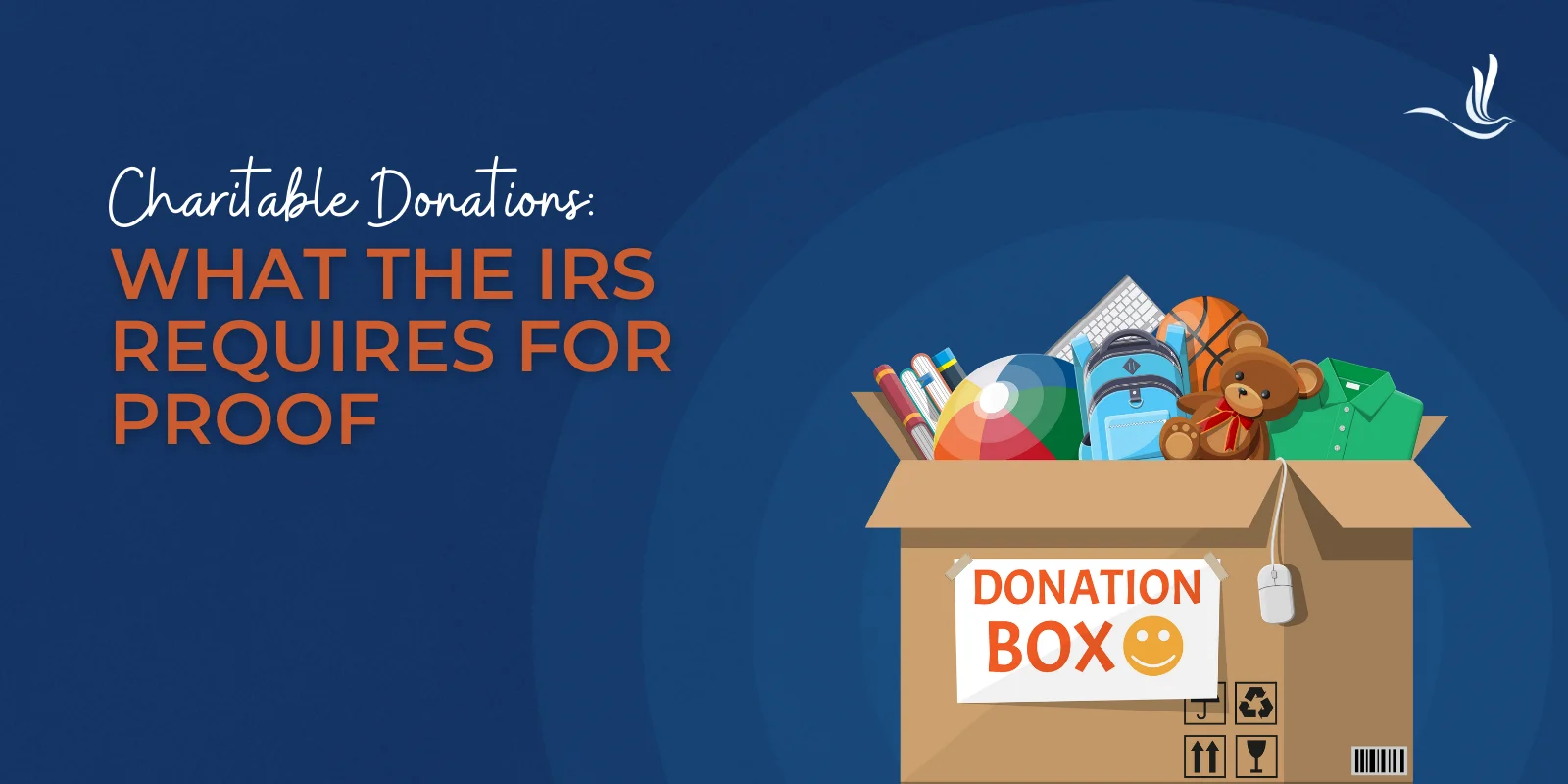Key Takeaways:
Charitable donations are deductible only if given to qualified 501(c)(3) organizations, including religious, educational, and charitable nonprofits.
Cash donations under $250 require a bank record or receipt, while donations of $250 or more require a written acknowledgment detailing any goods or services received.
Non-cash contributions require documentation based on value: under $250 needs a receipt, $250–$500 needs a written acknowledgment, $501–$5,000 requires IRS Form 8283, and over $5,000 mandates a professional appraisal.
Fair market value (FMV) determines the deductible amount for property donations, accounting for condition, age, and resale value.
Adjust deductions when receiving goods or services; the deductible amount equals the donation minus the fair market value of anything received.
Keep organized records—including receipts, acknowledgments, photographs, inventories, and Form 8283—to substantiate deductions and ensure IRS compliance.
Claiming charitable donations on your taxes can reduce your taxable income, but the IRS requires specific documentation to prove your deductions. Whether you donate cash, property, or other items, knowing exactly what counts as valid charitable donations tax deduction proof ensures your contributions are deductible and protects you in case of an IRS audit. This guide explains all you need to know about documentation, recordkeeping, valuation, and IRS reporting rules.
What Counts as a Charitable Donation?
Before tracking receipts and forms, it’s crucial to understand what the IRS considers a deductible donation. Not every gift or contribution qualifies.
Qualified Charitable Organizations
The IRS allows deductions only for contributions to qualified organizations, primarily those recognized as 501(c)(3) nonprofits, which generally include:
Religious organizations such as churches, synagogues, mosques, and temples
Educational institutions including schools, colleges, and universities
Charitable nonprofits like the Red Cross, Salvation Army, and local food banks
For example, donating $1,000 to a local fire department or a 501(c)(3) nonprofit that supports children in need is deductible. Donating the same amount to a political campaign or a personal friend is not.
Types of Donations
Charitable contributions fall into two main categories:
Cash donations: Direct monetary contributions via cash, check, electronic funds transfer, or credit card.
Non-cash contributions: Physical items such as clothing, household goods, vehicles, artwork, or collectibles.
The IRS applies different rules depending on the type of contribution and its value, which directly impacts the documentation you’ll need.
Documentation Required for Cash Donations
Cash donations are straightforward in theory but must be documented appropriately to claim a tax deduction. The IRS differentiates based on the amount of the donation.
Cash Donations Under $250
For donations below $250, the IRS requires:
A bank record (canceled check, credit card statement, or bank statement)
OR a receipt from the organization acknowledging the contribution
For example, donating $75 via PayPal to a local animal shelter? Keep the PayPal receipt or your bank statement to substantiate your deduction.
Cash Donations of $250 or More
Donations of $250 or more require a written acknowledgment from the organization, which must include:
Date and amount of donation
A statement about any goods or services received in return
If goods/services were provided, a description and good-faith estimate of their value
For instance, donating $500 to a museum that provides a free ticket valued at $50 means your deductible contribution is $450. The museum’s acknowledgment should reflect this. Maintaining organized records of all donations is critical. Digital or paper copies of receipts and statements should be kept, along with notes describing the purpose of the donation. Even small contributions add up over time, and proper documentation ensures you can substantiate every claim.
Proof for Non-Cash Donations
Non-cash donations require more careful documentation, particularly for high-value items. The IRS differentiates requirements based on the value of the donation.
Donations Under $250
For non-cash items valued under $250:
A receipt from the charity describing the items
Your own record of item condition and estimated value
The name and address of the qualified organization you contributed to
The date and location of the charitable contribution
For example, donating gently used clothing worth $100 to Goodwill requires a receipt listing the items. Taking photos can provide additional proof.
Donations Between $250 and $500
For donations in this range, a written acknowledgment is required from the organization, along with a description of the items. A professional appraisal is not necessary at this level, but maintaining an inventory with notes on condition and estimated value is recommended. Donating a set of silverware valued at $350, for instance, would require a written acknowledgment and detailed personal records.
Donations Between $501 and $5,000
Non-cash donations exceeding $500 require completion of IRS Form 8283. This form requires a detailed description of the donated items and documentation of how fair market value was determined. Donating a laptop and monitor valued at $1,200 would necessitate Form 8283, listing model numbers, condition, and estimated fair market value.
Donations Over $5,000
High-value donations over $5,000 require a qualified appraisal conducted by a certified appraiser. The completed Form 8283 must be signed by both the donor and the receiving organization, and all supporting documentation should be attached to your tax return. For example, donating a vintage guitar valued at $6,500 requires a professional appraisal and Form 8283 with all item details.
Determining Fair Market Value
Fair market value is defined as the price a willing buyer would pay a willing seller. Factors such as item condition, age, and current resale value influence FMV. Online resources, auction results, and professional appraisals are helpful for higher-value items. A five-year-old furniture set in good condition, for example, might have an FMV of $800 even if it was originally purchased for $2,000.
Using IRS Form 8283 for Property Donations
Form 8283 standardizes reporting for non-cash donations and ensures the IRS can substantiate your deductions. It is required for non-cash donations exceeding $500 and for certain types of property like art, collectibles, and vehicles. It requires donor and organization information, a detailed description of the property and its condition, and the method used to determine fair market value. Both the donor and the receiving organization must sign the form.
For donations over $5,000, a professional appraisal is mandatory. The IRS also imposes annual deduction limits. Cash donations are typically limited to 50% of your adjusted gross income, while property donations are limited to 30%. Donations exceeding these limits may be carried forward for up to five years. For example, if your AGI is $100,000, you could deduct up to $50,000 in cash donations and $30,000 in property donations in one year, carrying forward any excess to future years.
Special Considerations for Goods or Services Received
When you receive goods or services in exchange for a donation, the IRS requires you to adjust your deduction accordingly. If only intangible religious benefits are received, such as prayers or blessings, the full donation remains deductible. For example, a $300 donation to a church that only provides a blessing is fully deductible. However, if the charity provides tangible goods or services, the deductible amount must be reduced by their fair market value. A $500 donation to a charity gala that includes a dinner valued at $75 would allow a deduction of only $425. Understanding this adjustment ensures compliance and prevents overstated deductions.
What Records Are Sufficient Without a Receipt
Sometimes receipts are lost or not issued. The IRS allows alternative documentation for claiming deductions. For cash donations under $250, bank or credit card statements showing the payment date, amount, and charity name are generally sufficient. For non-cash items without receipts, photographs or inventory lists can serve as proof. Maintaining a detailed record of each item’s description, quantity, condition, and estimated fair market value further proves your deduction. If records are missing, contacting the charity for a duplicate acknowledgment or using bank statements and email confirmations can reconstruct proof. For example, donating twenty books to a school library without a receipt can be documented with a photograph and a list noting the titles and condition.
Frequently Asked Questions About Charitable Donations
How does the IRS verify charitable donations?
The IRS verifies charitable donations by reviewing bank records, receipts, written acknowledgments, and IRS Form 8283 for non-cash contributions over $500, ensuring deductions match donations to qualified organizations.
What donations can I claim without a receipt?
Cash donations under $250 can be claimed with bank or credit card statements, while non-cash items without receipts can be substantiated using photographs, inventories, and detailed notes on condition and value.
Does the IRS audit charitable donations?
Yes, the IRS may audit charitable donations, especially large or unusually frequent contributions, missing documentation, or discrepancies in deduction amounts compared to income.
What does a donation receipt need?
A donation receipt must include the charity’s name, date of contribution, donation amount, and a description and value of any goods or services received in return.
Tax Help for Charitable Donors
Proper recordkeeping involves maintaining receipts, written acknowledgments for contributions over $250, completing Form 8283 for property donations over $500, and using appraisals for items over $5,000. Adjust deductions for goods or services received, and consider strategies like bunching or donor-advised funds to maximize benefits. Adhering to these guidelines ensures that charitable giving not only supports causes you care about but also provides tangible tax benefits. If you need help, consult with a knowledgeable tax professional. Optima Tax Relief is the nation’s leading tax resolution firm with over a decade of experience helping taxpayers with tough tax situations.
If You Need Tax Help, Contact Us Today for a Free Consultation


























